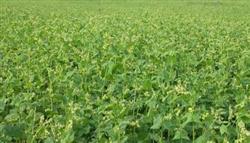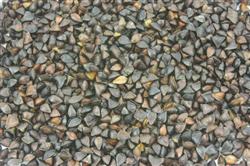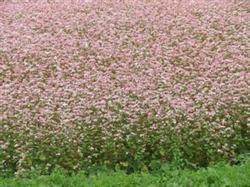Cultivation techniques of Fagopyrum esculentum

Golden buckwheat is the dry rhizome of buckwheat in Polygonaceae, also known as Tartary buckwheat, Yeqiao buckwheat, buckwheat. It has the functions of clearing heat and detoxification, promoting blood circulation and removing blood stasis, invigorating the spleen and promoting dampness. Mainly produced in Shaanxi, Jiangsu, Zhejiang, Hubei, Hunan and other provinces, East China can also be cultivated. Fagopyrum esculentum is a perennial herb with a plant height of 1-1.5 meters. The taproot is thick, nodular, transverse, reddish brown. Stem erect, reddish, much branched, furrowed. Simple leaves alternate, leaf blade hastate-triangular, apex long, acuminate or caudate, base precordate; stipitate, white pubescent on stalk; Ocrea tubular membranous. Cymes terminal or axillary, tepals 5, white. Achenes, ovate-trigonous, reddish brown. The flowering period is from July to September and the fruiting period is l0-l1 month. Second, Fagopyrum esculentum has strong adaptability and likes warm climate. It grows well at the temperature of 15 ℃ 30 ℃, and can survive the winter safely in the area of-15 ℃. It is suitable to be planted in fertile and loose sandy loam, but the yield and quality of clay and poor drainage are poor. The seeds of Fagopyrum esculentum must absorb about 40% of their body weight in order to germinate, and can germinate in the temperature range of 8 ℃ and 35 ℃. The optimum temperature is 12 ℃ and 25 ℃, and the germination is inhibited when the temperature is lower than 8 ℃ or higher than 35 ℃. Golden buckwheat was sown in Beijing in April and maintained a certain humidity. The temperature was in the range of 12 ℃ and 18 Mel. The seedlings could emerge in about 15 days, and the peak emergence period was 20 days. Three cultivation techniques 1. According to the growth habits of buckwheat, the sandy loam with good drainage and high dry terrain was selected. Soil preparation is generally carried out in spring, with the principle of not turning over the raw soil, with a ploughing depth of 30-60 cm and continuous ploughing for 2 times. And combined with ploughing, 2500 Mu of stable manure or compost is applied to 3,500 kg per mu, and then raked fine and leveled to form a bed 1.5 meters wide, with a length depending on the topography, usually 8 Mui 10 meters. 2. Propagation methods seed propagation, rhizome propagation or cutting propagation can be used. (1) seed reproduction can be sowed in spring or autumn, and spring sowing is better. Spring sowing in late April, strip sowing according to 45 cm ditch, ditch depth of 3 cm, evenly sowed seeds, covered with soil rake flat, slightly suppressed, after sowing the soil to keep moist, under the temperature of 10 ℃ 18 min, 15 min 20 days seedling; late autumn sowing, late October or November, after sowing border covered with grass, seeds overwintering in the soil, the following April emergence, the emergence rate can reach 60%. Seedling transplanting can also be carried out: in Beijing area, seedlings can be raised in greenhouse or sunny border in the early and middle of March, and in the whole sunny border, water can be watered thoroughly and sowed according to row spacing of 5m / m and covered with soil of 2cm. The border surface can be covered with plastic film, covered with grass at night, and seedlings will emerge in 10 days. When there are 3 true leaves, transplant will be carried out according to the row spacing of 30cm × 45cm. (2) Rhizome propagation before plant germination in spring, dig out the rhizome, select healthy rhizome and cut it into small segments, trench according to the row spacing of 45 cm, ditch depth of 10 mi 15 cm, then plant the rhizome into the trench according to the plant spacing of 30 cm, cover the soil and compact. Generally, the young part of rhizome and rhizome bud are selected as propagating wood, and the survival rate and yield of seedling emergence are high. (3) Cuttage propagation cut off the branches with abundant tissue, which is 15mur20cm long and has 2Mel 3 nodes. The river sand is used as the seedbed, the cutting depth is 2cm 3, and the plant spacing is 9cm × 12cm. Keep the seedbed moist, the cuttings take root after about 20 days in summer, and the survival rate is more than 90%. 3. Field management (l) weeding and weeding at seedling stage, loosening the soil for 3 times. (2) topdressing should be carried out once when the seedling height is 50ml / 60cm, or before flowering, 15-20kg of chemical fertilizer per mu. (3) drainage and irrigation should pay attention to timely drainage in the rainy season and appropriate watering according to soil moisture in case of drought. 4. Pest control (1) aphids and their nymphs feed on the stem and leaf sap of golden buckwheat. Control methods: ① cleans the garden in winter and burns the dead branches or leaves to eliminate overwintering insects; ② is sprayed with 1500 times of 40% dimethoate emulsion or 1500 times of 80% dichlorvos emulsion. (2) the virus disease was harmful to the leaves, and the damaged leaves were mosaic or curled and wrinkled. Control methods: ① can select disease-free plants and passivate the virus before sowing, ② control media, remove diseased branches, remove field weeds and so on to reduce the source of field infection. (4) timely harvest and correct processing and drying methods are particularly important for golden buckwheat, and the correct harvest and processing can achieve high yield and high quality. Generally, when the aboveground stems and leaves wither in autumn and winter, they are dug, cut off the stems and leaves when harvested, dig out the roots, remove the soil and sand, and take out some of the robust and disease-free roots for seed use. Other dry processing is used as medicine, generally, the yield per mu can reach 250 Mu 400 kg; aboveground, including stems, leaves, flowers, 500-900 kg, can also be used medicinally. Dry the cleaned buckwheat root or take advantage of fresh slices and then dry. Drying method: drying in the sun, drying in the shade, drying within 50 ℃, but pay attention to the temperature when drying should not be too high, it is best not to exceed 50 ℃, if it exceeds this temperature, the quality of medicinal materials will decline significantly. The golden buckwheat is better if it is big and hard.
- Prev

Sowing buckwheat depends on the season.
Buckwheat emerges with leaves, which is difficult to emerge, and sowing should not be too deep. The sowing depth directly affects the neatness of seedling emergence, which is the key to the whole seedling. To master the sowing depth, first, it depends on the soil moisture, which is sufficient and shallow, and the lack of moisture is deep. Second, it depends on the sowing season, spring buckwheat should be deep, summer buckwheat is slightly shallow, and third, it depends on the soil quality. Sand.
- Next

Technical points of replanting buckwheat
The growth period of buckwheat is short, and it can mature in 80 days. The key points of high-yield cultivation techniques of autumn buckwheat are as follows: 1. Fine soil preparation. The unearthing ability of buckwheat seedlings is weak, so we should pay attention to fine soil preparation and create an environment conducive to the growth and development of buckwheat seedlings. 2. High quality sowing. Buckwheat the Beginning of Autumn before and after sowing.
Related
- The first cup of black tea in spring, the flavor and history of tea gardens in Kenya, Africa
- The computer can not only choose potatoes, but also grow tea rice. AI will grow winter oolong tea champion.
- It is not only the inflated tea bitten by insects, but also engraved with the four seasons tea in Beipu.
- The Oriental Beauty Tea Festival in Zhuxian County takes the stage at the weekend to experience the plus-size feast of oil tea.
- & quot; Oriental Beauty Tea & Exploration of Emei in Hsinchu, the hometown of quot;
- The new variety of strawberry "Tainong 1" dessert is the first choice with mellow aroma. Crimson gorgeous
- History of Tea in Taiwan: from Wild Inner Mountain to Export Tea Garden
- Two types of Taiwan Oriental Beauty Black Tea won the British three-Star Award for Childhood Tea Xiang Zhang Jiaqi changed from pilot to champion tea maker.
- Banana species and varieties: the planting history of Taiwan Xianren banana and dwarf banana is long, is banana disease resistant?
- Coffee planting Technology: Qianjie Coffee from Seedling to harvesting

